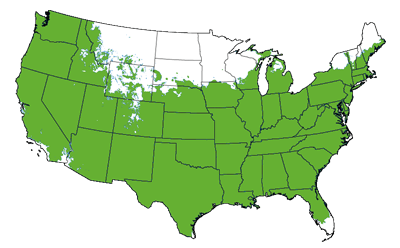Forest Pansy Redbud
Product Details
 Growing Zones 5-9
Growing Zones 5-9
| Soil Type | Adaptable |
| Sunlight | Full, Partial |
| Drought Tolerance | Good |
| Mature Height | 20-30 Feet |
| Mature Width | 20-30 Feet |
| Growth Rate | Fast |
| Fall Color | Yellow |
| Bloom Color | Purple |
| Shipping Restriction | AZ, OR |
The Forest Pansy Redbud's job is never really done. Beautiful color could be seen for more than a few weeks or months with this medium-sized, compact tree. If you are looking for that tree to add a little sparkle to your landscape, try the Forest Pansy Redbud.
Unlike other Redbuds, the Forest Pansy Redbud produces a wine color purple leaf in the spring after the flowers have faded. Clusters of tiny, rose-purple, pea-like flowers bloom on gray branches that stretch out vertically for 2-3 weeks in early spring (March-April), before the foliage emerges.
Flowers are darker and more purplish than other ones that you see. Heart-shaped leaves open bright reddish-purple and gradually mature to a more subdued purple as summer approaches. The Forest Pansy Redbud is the perfect flowering tree for zone 5, zone 6, zone 7, zone 8, or zone 9.
The leaves of the Redbud turn green by this point. Spurts of purple are possible as the season goes on. The leaves of the Forest Pansy then turn yellow as the fall season arrives.
The Forest Pansy Redbud has a rapid growth rate. At maturity, you could expect it to be between 20-30 ft tall, with a 15-20 ft spread. Though they do best in light, rich soil, Forest Pansy’s will adapt to any soil (clay, sand, alkaline etc.). They are both drought and pollution-tolerant. In order to grow and produce beautiful flowers, the Forest Pansy Redbud does require sunlight. The more sunlight the Forest Pansy has the better.
Why Doesn't My Forest Pansy Redbud Bloom?
Consider the fact that redud trees dont normally flower until they are mature enough. Be sure your tree is getting full sun to part shade exposure for proper blooming to occur.
How To Propagate A Redbud
Use a cutting that is atleast 6" long, remove half of the bark and dip in rooting hormone then plant in warm soil. Keep cutting hydrated for 4 weeks until the roots establish and plant in spring for best results.
What Are Good Companion Plants For This Tree?
Dianthus, phlox, and daisies all pair well with this redbud in lawns, gardens or naturalized areas. This tree is often used as a street tree in residential neighborhoods.
The best way to prevent disease and pests is by providing the appropriate care for your plants. Proper location choice, watering and fertilization are the keys to your success. Avoid problems with Borer insects by ensuring your tree remains free from damage, especially from lawn equipment. Mulching helps to keep weeds at bay which eliminates the need to use lawn equipment near your tree. Borers look for a hole or weak spot to penetrate. Scale is an immobile insect that can affect almost any tree. You can treat this pest with horticultural oil. Be sure to coat the entire tree.
Planting
When planting your Forest Pansy Redbud be sure you have the right location and conditions for your new tree to thrive. Spring and fall are ideal times to plant. However, if you avoid extreme temperatures you can plant almost any time of the year.
Redbuds are very easy to maintain. These trees tolerate full sun, part sun, and part shade and are adaptable to any soil as long as it isn't saturated.
Watering
Water your new Redbud deeply about twice a week for the first couple months. After establishment, this redbud is drought tolerant. In extended drought periods this tree will benefit from a weekly deep watering. Add a layer of 2 of mulch around the base of the tree about the size of the tree canopy. Do not allow the mulch to touch the trunk as this increases the chances of pests and disease.
Fertilizing
Fertilize in early spring and when planting to give your tree a boost. Choose a balanced, slow-release fertilizer.
Maintenance
Redbuds don't generally require pruning, but if needed, prune immediately after blooming has ceased to remove any dead, dying, crowded or crossed branches. Pruning in winter is likely to cause bloom loss.
Whether used as a specimen or grouped together it is a beautiful landscape tree. The Forest Pansy Redbud is perfect for lawns, gardens or naturalized areas. It is often used as a street tree in residential areas. Want a different color? Try the Eastern, Royal White or Oklahoma Redbud trees.
Plant your new Redbud Tree in the center of your front lawn. View our designs for more ideas. You can always install a kidney shaped bed with some yellows and blues to really add character to your home. Your neighbors will always ask you what kind of tree is that... No matter where you choose to plant this Redbud it will make a great addition to your property.
For additional options, be sure to check out our Rising Sun Redbud and the Redbud Tree collection.












